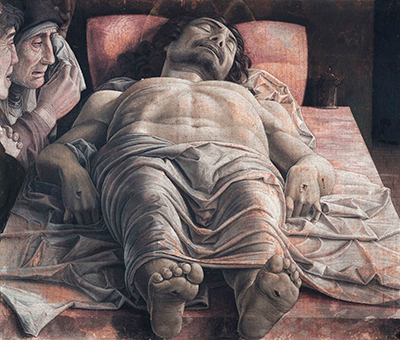The Lamentation of Christ was painted by Andrea Mantegna between 1475 and 1501, with some debate as to the exact date, but it is believed to have been completed during the early 1480s.
It depicts Jesus Christ lying on a marble slab after his death, cleaned and loosely covered with a cloth. He is accompanied by a grieving Virgin Mary and Saint John, the nail holes in his hands and feet clearly visible, as are the marks and bruising on his skin. Unlike many contemporary paintings of Christ, this is not an idealised image we are presented with, but rather a study of realism. Whereas most other artist's Lamantation paintings focused on the grief and lament of the distraught mourners, Mantegna presents us with the stark reality of the body after death. Certainly the most striking aspect of this painting is the perspective, indeed it is probably the most famous example of foreshortening ever painted.
Viewers of the painting see Christ's feet first, with his entire body filling the painting, framed by the marble slab on which he lays. Whilst on first inspection this looks like a perfect representation of a body seen from the feet up, in fact Mantegna had to reduce the size of the feet in order that they did not obscure the view of the rest of the body. Mantegna's uses his skill in the technique of chiaroscuro to great effect in this painting, creating great realism and depth using light and shadow. In particular, Christ's torso is vividly represented and life-like. His interest in this area was nurtured by his adoptive father and teacher Francesco Squarcione, who encouraged his interest in Greek sculpture and modelling of figures. Like many other early Renaissance artists, Mantegna preferred to work in tempera, as in this painting, rather than oils.
The painting was probably in Mantegna's workshop for around thirty years, leading to the belief that he painted it for his own personal tomb in San Addrea in Mantua. After having been displayed with his coffin during his funeral, it was sold to pay off his debts. Owned briefly by Sigismondo Gonzaga, it has resided in the Pinacoteca di Brera of Milan since 1824. This venue is claimed by some to be the first and foremost paintings gallery in the city of Milan and focuses most on Italian artists. Mantegna is well represented here besides just The Lamentation of Christ, plus they also have a number of related painters featured here such as Piero della Francesca, Giovanni Bellini, Tintoretto, Annibale Carracci and also Correggio. They continue to add new items to the collection but these days it is rare to find anything from the old masters to become available, and even fewer will be at an affordable price.




